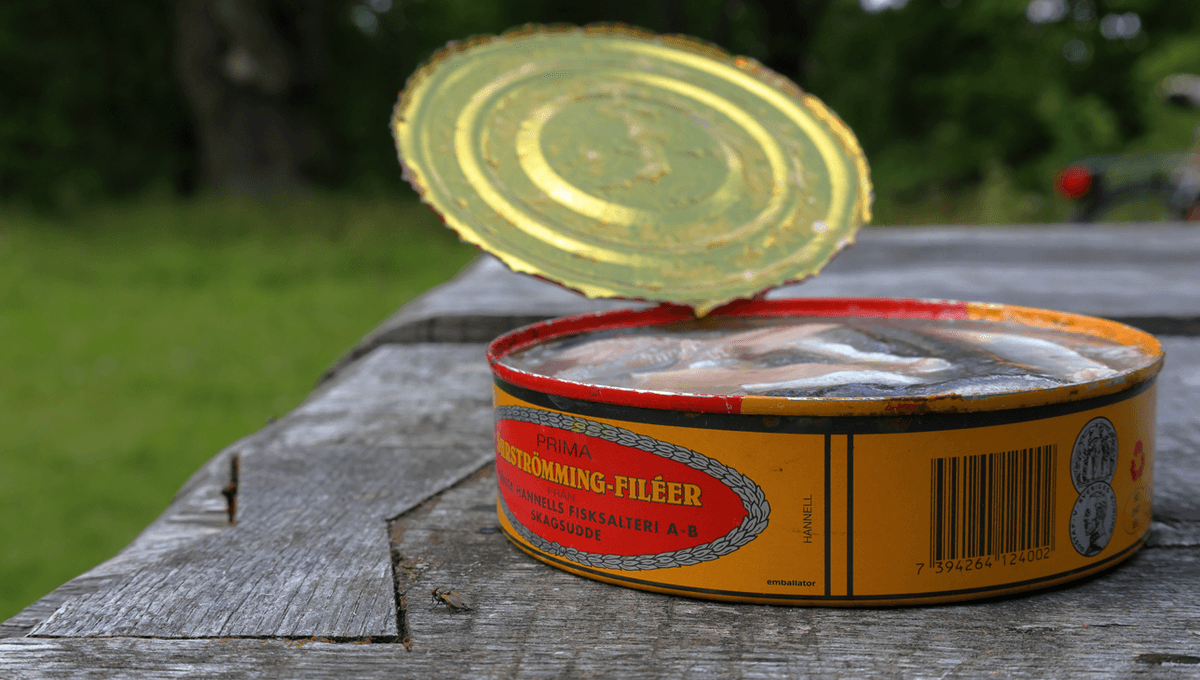
Surströmming is a regular cast member of viral videos where fame-hungry content creators crack open a can and (more often than not) proceed to gag, choke, and splutter as they attempt to eat this unusual-looking slurry of fish. But what exactly is this curious delicacy, and why does it smell so notoriously terrible? Fortunately, science has some answers.
What is surströmming?
Surströmming (pronounced sur-stroh-ming) means “sour herring” in Swedish. It’s a traditional Swedish delicacy with a reputation for being one of the stinkiest foods in the world.
It’s essentially slightly salted Baltic herring that’s been left to ferment for months.
The fish are caught in the Baltic Sea between Sweden and Finland in the springtime. Their heads are removed while their roe are left in, then their bodies are packed into giant barrels with a weak brine (around 17 percent salt) to ferment. They’re typically held at a temperature of 15 to 18°C (59 to 64°F) – a pleasant and mild atmosphere for certain bacteria – for up to 12 weeks.
During this time, the fishy concoction will start to bubble with gas as the bacteria thrive and metabolize. The microbial activity is so great that taps are fitted onto the barrels to burp the gases and prevent a deeply unpleasant explosion. The partially preserved herrings are then transferred to airtight tins where they continue to ferment for up to another year.
The end result is a can containing fizzy, reddish fish flesh in a pool of cloudy water.
What does surströmming smell of?
When opening a tin of surströmming, it will let out a hiss as the trapped gases escape. As it does so, a spirited aroma will fill the air and infiltrate your nostrils. For many, the urge to heave quickly follows.
The smell is often compared to a mix of rotten eggs, pungent cheese, ammonia, week-old armpit, and putrid fish. American author Mark Kurlansky described it as “bubbling like fermented cider and smelling like a blend of Parmesan cheese and the bilge water from an ancient fishing vessel.”
The taste of surströmming is reportedly more pleasant than the stench, although it still packs a punch, said to taste like super-tangy and complex fermented fish. However, many people with a weaker disposition are unable to get past the smell, which is explicitly tied to our sense of taste.
The science: why does surströmming smell so strong?
In 2020, Italian researchers from Marche Polytechnic University published a comprehensive study on the science of surströmming, examining the microbes and volatile compounds that give it its infamous odor.
The findings showed that the light brine managed to ward off bacteria that cause food poisoning, such as Salmonella, Listeria, and botulinum toxin, which were nowhere to be found in the cans.
Meanwhile, the salty, low-oxygen conditions did allow some bacterial species to thrive. The star player is a bacterium called Halanaerobium praevalens, but there are also significant quantities of Alkalibacterium gilvum, Carnobacterium, Tetragenococcus halophilus, Clostridiisalibacter, and Porphyromonadaceae.
Many of these bacteria produce lactic acid, propionic acid, butyric acid, and hydrogen sulfide, which enrich surströmming with its tangy, sour flavour. The acids also lower the pH in the can, further reducing the risk of pathogenic bacteria that could make you sick.
Why do people eat surströmming?
It said that surströmming emerged in northern Sweden in the 16th century during King Gustav Vasa’s Rebellion, aka the Swedish War of Liberation, when there was a salt shortage, forcing people to adopt a preservation method that required minimal brine.
One popular retelling of its origin story says the salt-deprived Swedes sold a barrel of this strangely preserved fish to the Finns. Surprisingly, some people liked the pungent delicacy and the recipe stuck.
How to eat surströmming (if you dare)
If you’re still brave enough to taste surströmming, the Swedish tourism board has your back with some survival tips.
Step one: don’t just pop the can in your kitchen. Since it’s pressurized, open it underwater in a bucket, unless you want Eau de Fish all over your house. This will also help to contain some of the smell. Many will advise you to do this outside, for obvious reasons.
Step two: give the herring a rinse, gut it, and then bundle it up in buttered tunnbröd (a slightly sweet flatbread) with sliced almond potatoes and chopped onion. Finally, add beer, a shot of traditional liquor, and a table full of friends. Because let’s be honest, this is the kind of culinary adventure you don’t attempt alone and sober.
Source Link: Surströmming: Why Sweden’s Stinky Fermented Fish Smells So Bad (But People Still Eat It)